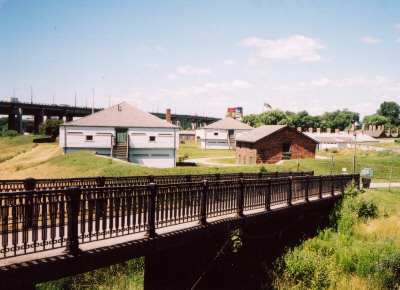The buildings seen here from Bathurst Street are not those of the fort captured by the Americans in 1813, but rather the new and improved fort built in1816 in case the invaders returned.

John Graves Simcoe, first Lieutenant Governor of Upper Canada, chose this site in 1793 and started to build a fort but due to lack of funding was only able to clear the site and erect a few simple huts with no fortifications. His plan was to make it a place which, “fortified with a few heavy Guns,” would prevent “any vessel from entering the harbour, or from remaining within it.” A blockhouse was started , but only complete in 1797, after he had returned to England. Another blockhouse was erected near the Don River in 1799. Improved huts were built east of Garrison Creek and a one-story lieutenant governor’s residence on the west side of the creek, but little more until 1812, when Isaac Brock, Commander-in-chief of the British troops in Upper Canada added a gunpowder magazine and excavated a dry moat, west of the residence.
On April 27, 1813 the Town of York was invaded by 1,700 American troops. Fort York was a key objective. Greatly outnumbered, the fort’s defenders withdrew, but not before blowing up the town’s gunpowder magazine. This explosion destroyed the fort and killed or wounded 250 of the invading troops. After the Americans left in August the British drew up plans to rebuild the fort. By 1816, eighteen buildings stood within the walls of Fort York. Up to one thousand men could live in the fort. The wall was a barricade of earth with sharpened logs facing outward at the east and west ends and cannon placed in the bastions. While the rebuilt Fort York was better prepared, no attack was ever happened. During the years of peace, the fort served mainly as a supply base and a hospital for regular troops, and as a training ground for the local militia.
The number of troops garrisoned at Fort York declined gradually after 1816. except when more troops were sent to Upper Canada after the Rebellion of 1837. A large two-story barracks was built west of Fort York in 1841 termed the “New Fort,” but later called Stanley Barracks. No defence works, however, were ever installed to protect the new buildings. A heavy seven-gun battery was installed along the south wall of Fort York in the 1860’s at the time of the American Civil War. After Confederation, the new federal government of Canada took on the responsibility for defending Canada and created a Canadian Army. British troops left Canada in 1870. The military installations at Toronto became the headquarters of the Toronto military district.
The first restoration of Fort York as a historic site was done for Toronto’s centennial in 1934. In 1949, further work restored the buildings and site to what it had been like in 1816. Heritage Toronto now maintains the site as a living museum to recreate for visitors the sights and sounds of a nineteenth century British garrison. Soldiers, uniformed and equipped in the style of the War of 1812, perform sentry duty, musket and cannon firings, and ceremonial drills. For more information about the fort see “Fort York” by Donald Feather & George Waters, Ginn and Company 1972.
For more information on Fort York, try the link to the Friends of Fort York website at www.fortyork.ca or the city’s page on the fort at www.toronto.ca/fortyork
The definitive and highly readable, well-illustrated book on the history of Fort York: “Historic Fort York 1793 - 1993” by Carl Benn (Natural Heritage, Natural History, Inc., Toronto, 1993) has also been recommended.
